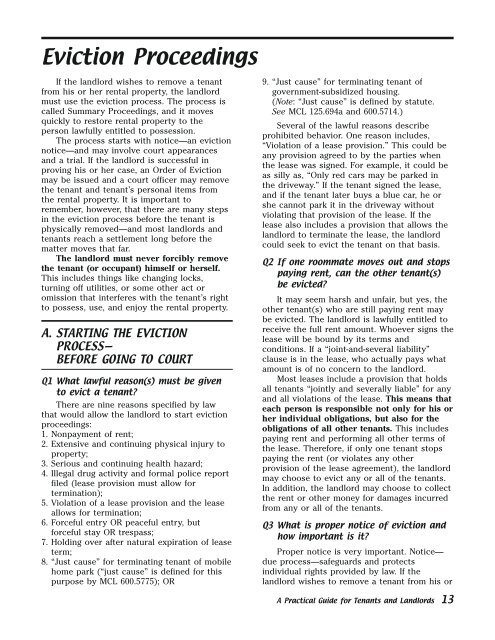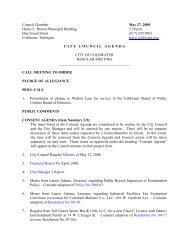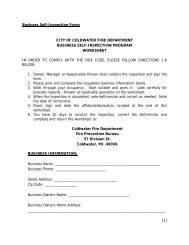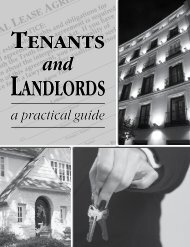Landlord Tenant Guide - State of Michigan
Landlord Tenant Guide - State of Michigan
Landlord Tenant Guide - State of Michigan
- No tags were found...
You also want an ePaper? Increase the reach of your titles
YUMPU automatically turns print PDFs into web optimized ePapers that Google loves.
If the landlord wishes to remove a tenantfrom his or her rental property, the landlordmust use the eviction process. The process iscalled Summary Proceedings, and it movesquickly to restore rental property to theperson lawfully entitled to possession.The process starts with notice—an evictionnotice—and may involve court appearancesand a trial. If the landlord is successful inproving his or her case, an Order <strong>of</strong> Evictionmay be issued and a court <strong>of</strong>ficer may removethe tenant and tenant’s personal items fromthe rental property. It is important toremember, however, that there are many stepsin the eviction process before the tenant isphysically removed—and most landlords andtenants reach a settlement long before thematter moves that far.The landlord must never forcibly removethe tenant (or occupant) himself or herself.This includes things like changing locks,turning <strong>of</strong>f utilities, or some other act oromission that interferes with the tenant’s rightto possess, use, and enjoy the rental property. There are nine reasons specified by lawthat would allow the landlord to start evictionproceedings:1. Nonpayment <strong>of</strong> rent;2. Extensive and continuing physical injury toproperty;3. Serious and continuing health hazard;4. Illegal drug activity and formal police reportfiled (lease provision must allow fortermination);5. Violation <strong>of</strong> a lease provision and the leaseallows for termination;6. Forceful entry OR peaceful entry, butforceful stay OR trespass;7. Holding over after natural expiration <strong>of</strong> leaseterm;8. “Just cause” for terminating tenant <strong>of</strong> mobilehome park (“just cause” is defined for thispurpose by MCL 600.5775); OR9. “Just cause” for terminating tenant <strong>of</strong>government-subsidized housing.(Note: “Just cause” is defined by statute.See MCL 125.694a and 600.5714.)Several <strong>of</strong> the lawful reasons describeprohibited behavior. One reason includes,“Violation <strong>of</strong> a lease provision.” This could beany provision agreed to by the parties whenthe lease was signed. For example, it could beas silly as, “Only red cars may be parked inthe driveway.” If the tenant signed the lease,and if the tenant later buys a blue car, he orshe cannot park it in the driveway withoutviolating that provision <strong>of</strong> the lease. If thelease also includes a provision that allows thelandlord to terminate the lease, the landlordcould seek to evict the tenant on that basis. It may seem harsh and unfair, but yes, theother tenant(s) who are still paying rent maybe evicted. The landlord is lawfully entitled toreceive the full rent amount. Whoever signs thelease will be bound by its terms andconditions. If a “joint-and-several liability”clause is in the lease, who actually pays whatamount is <strong>of</strong> no concern to the landlord.Most leases include a provision that holdsall tenants “jointly and severally liable” for anyand all violations <strong>of</strong> the lease. This means thateach person is responsible not only for his orher individual obligations, but also for theobligations <strong>of</strong> all other tenants. This includespaying rent and performing all other terms <strong>of</strong>the lease. Therefore, if only one tenant stopspaying the rent (or violates any otherprovision <strong>of</strong> the lease agreement), the landlordmay choose to evict any or all <strong>of</strong> the tenants.In addition, the landlord may choose to collectthe rent or other money for damages incurredfrom any or all <strong>of</strong> the tenants. Proper notice is very important. Notice—due process—safeguards and protectsindividual rights provided by law. If thelandlord wishes to remove a tenant from his or





